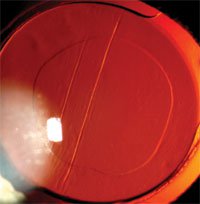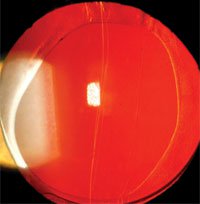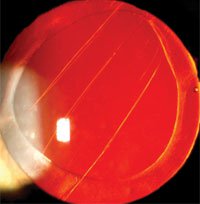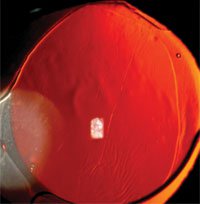Sealed-capsule device shows promise in early results
Results at 6 months suggest that use of the PerfectCapsule device may prevent PCO in the longer term.
Early results with a device that allows irrigation of the inside of the capsular bag with sterile water indicate that the treatment may prevent capsular fibrosis without damaging ocular tissues.
The PerfectCapsule device, made by Milvella Pty. Ltd., may be a valuable adjunct for refractive lens exchange if it proves effective in the long-term in preventing anterior and posterior capsular opacification, surgeons experienced with the device suggested.
Sealed-capsule irrigation (SCI) with sterile deionized water using the PerfectCapsule system was found to be a suitable method for preventing PCO in cataract surgery, according to Gerd U. Auffarth, MD, speaking at the 2004 American Academy of Ophthalmology meeting. Early postoperative follow-up found no corneal endothelial cell damage or change of corneal thickness after use of the system.
“We have seen a stable development of visual acuity and a tendency towards less fibrotic reaction with SCI,” Dr. Auffarth said. But he said longer follow up is necessary to confirm the positive early results with the PerfectCapsule device.
The injection-molded silicone disposable device is used to irrigate the interior of the capsular bag after cataract removal, Dr. Auffarth explained. The device is placed on the anterior surface of the empty capsular bag and vacuum is applied to a vacuum ring to seal the capsular opening. Through an irrigation port, an agent can be applied to the interior of the capsular bag, targeting the lens epithelial cells. The SCI isolates the internal lens capsule and facilitates the removal of residual cortical material and lens epithelial cells, thereby preventing or delaying capsular bag opacification, Dr. Auffarth said.
The PerfectCapsule system is approved by the U.S. Food and Drug Administration and is available in the United States, Europe and Australia. However, what kinds of substances the surgeon can apply is not specified, and there is not an agent currently labeled for this use in the United States, he said.
Geoff Neilson, the chief executive officer of Milvella, said in an e-mail to Ocular Surgery News that the target population for SCI “is really refractive lens exchange patients, where expectations are higher and capsule opacification is likely to be more of a concern than in routine cataract surgery.”
“Without a solution to capsule opacification, the long-term acceptance of refractive lens exchange and accommodating lenses may be limited,” Mr. Neilson said.
 |  |
| Sealed-capsule irrigation with deionized water was used in these eyes, seen here at 1 to 6 months postop. | |
 |  |
| In these control eyes, no irrigation was used. | |
Preclinical, clinical study
Dr. Auffarth’s presentation was based on 6 to 9 months of follow-up, and he said he did not expect to see much difference in PCO between study and control eyes at that point.
“These results could be seen, at the earliest, at 1 to 2 years,” he said.
Dr. Auffarth described a preclinical study in which researchers tested the concept of the device in a laboratory setup using both distilled water and balanced salt solution. Each substance was mixed with fluorescein stain in order to check for complete sealing, he said. A histology study was performed on the capsular bags to determine how much cortical substance was left after irrigation. The researchers found that mechanical irrigation did not have much effect alone, but with the use of deionized distilled water clearer bags were seen, Dr. Auffarth explained.
In the clinical study, Dr. Auffarth explained, 19 patients were operated on bilaterally for cataract, with one eye receiving 2 minutes of irrigation with deionized distilled water through the PerfectCapsule device. The fellow eye of each patient had cataract surgery performed as usual without the distilled water irrigation and without use of the device. The Rayner 570 hydrophilic acrylic IOL, which has a sharp posterior optic edge that has been shown to be a factor in prevention of PCO, was used in all eyes, Dr. Auffarth said.
To assess safety, the researchers measured pachymetry and corneal endothelial cell count in all eyes before surgery and at 3 months postop. There was no difference between the control and study eyes, Dr. Auffarth said.
Regarding efficacy, Dr. Auffarth said the researchers assessed best corrected visual acuity, “and there was again no statistical difference between both eyes in this group.”
Using the Evaluation of Posterior Capsular Opacification (EPCO) system, which rates PCO on a scale of 0 to 4, Dr. Auffarth said at 6-months follow-up the mean EPCO value was below 0.5, which is low. There was a trend toward more fibrosis in the control eyes, but the difference was not statistically significant at that point, he said.
| PerfectCapsule system may aid with Crystalens implantation |
| Fibrosis of the capsule and capsular contraction may be reduced when the Milvella PerfectCapsule system is used in conjunction with implantation of the eyeonics Crystalens accommodative IOL, according to surgeons familiar with the two devices. Harvey L. Carter III, MD, has used the PerfectCapsule system when implanting the Crystalens. To date, he said in a telephone interview, he has implanted 25 to 30 eyes with the Crystalens using the PerfectCapsule system. “The PerfectCapsule system absolutely reduces fibrosis of the capsule and PCO,” Dr. Carter told Ocular Surgery News. Dr. Carter said he had 2 months of follow-up with these eyes as of January 2005. “What I am eager to see in the coming months in these patients, where one eye had straight cataract surgery and the fellow eye had cataract surgery with the PerfectCapsule system, is if there is a difference in the accommodative amplitude,” Dr. Carter said. One drawback with the PerfectCapsule system, according to Dr. Carter is that the system is “surgically challenging.” “The capsulotomy must be perfectly round and must be less than 5 mm to accommodate the injector,” Dr. Carter explained. But, he added, the system hopefully will reduce the posterior capsulotomy rate and can be used safely in a diabetic patient in whom the risk of PCO might be greater than in a patient without diabetes. David R. Hardten, MD, said in an interview with Ocular Surgery News that he has limited, but positive, experience with the combination of the Milvella device and the eyeonics IOL. In two eyes he has implanted with the Crystalens after use of the PerfectCapsule device, neither has developed capsular fibrosis, Dr. Hardten said. “Using the PerfectCapsule system may be worth the extra effort for the surgeon in reducing PCO in patients more susceptible to developing PCO,” Dr. Hardten said. “This is the time frame (4 months postoperative) in which a patient is likely to develop it.” One benefit of using the PerfectCapsule system with the Crystalens may be the reduction in bowing of the IOL anteriorly, or “Z” syndrome, Dr. Hardten said. He said there are currently no long-term studies on the combination of the two devices. For Your Information: |
Efficacy concerns
Several attendees and observers at the session commented on Dr. Auffarth’s results.
One audience member questioned the advisability of injecting distilled water into a patient’s eye.
“If there is a loss of vacuum, the presence of distilled water in the bag will leave my patient blind. and I am not willing to take that risk,” the attendee said.
In an e-mail interview with Ocular Surgery News, Dr. Auffarth noted that previous studies showed “no loss of vacuum in practically 100% of cases.” In addition, he said, a patient would not go blind from distilled water. In the case of vacuum loss, the distilled water is immediately diluted and washed out with balanced salt sodium through irrigation and aspiration. “That is the reason we use distilled water: It is harmless,” he said.
Another audience member commented, “Having a way to know if in fact the capsular bag is sealed before we inject distilled water, or whatever other substance that is found to be more efficacious, is crucial.”
Dr. Auffarth explained at the session that the seal is tested by using fluorescein in a balanced salt solution before proceeding with any agent.
“After a complete seal is assured, the irrigation with distilled water will be applied,” he said.
Mark Packer, MD, who moderated the session, commented, “I was surprised to see how little difference there is between using [the PerfectCapsule] and not using in it. This makes me feel better about reducing PCO without having to use something quite this dramatic.”
Dr. Auffarth said in an e-mail that, “for an experienced high-volume surgeon, application of this device is not ‘dramatic’ at all.” He said moderate skill should be sufficient in operating the PerfectCapsule system. The device is not intended for novices, he added.
David J. Apple, MD, was the discussant of Dr. Auffarth’s paper at the AAO meeting. He commented that, with current surgical measures and IOL design features, “we are putting off PCO, as opposed to total prevention.”
“I think this device will evidence not only a decrease in PCO but also show that cell proliferation is very important in all the modern IOLs that are being introduced,” Dr. Apple said. “IOLs are not designed to be effective against PCO; this is not their reason to exist. IOLs require marked and thorough cleanup to really be effective, and this instrumentation may be important for this.”
For Your Information:
- Gerd U. Auffarth, MD, can be reached at the University of Heidelberg, Department of Ophthalmology, INF 400, Heidelberg, D-69120, Germany; +49-62-21-56-66-31; fax: +49-62-21-56-17-26; e-mail: gerd_auffarth@med.uni-heidelberg.de. Dr.Auffarth has no direct financial interest in the products mentioned in this article, nor is he a paid consultant for any companies mentioned.
- David J. Apple, MD, can be reached at John A. Moran Eye Center, 50 North Medical Drive, Salt Lake City, UT 84132 U.S.A.; +1-801-581-2352; fax: +1-801-581-3357.
- Mark Packer, MD, can be reached at 1550 Oak St., Suite 5, Eugene, OR 97401 U.S.A.; +1-541-678-2110; fax: +1-541-484-3883; e-mail: mpacker@finemd.com.
- Milvella Pty Lt, manufacturer of the PerfectCapsule system, can be reached at 12100 Singletree Lane, Suite 100, Eden Prairie, MN 55344 U.S.A.; +1-952-746 1369; fax: +1-952-746 1201; Web site: milvella.com.
- Kim Norton is an OSN Correspondent based in Mt. Laurel, New Jersey.
